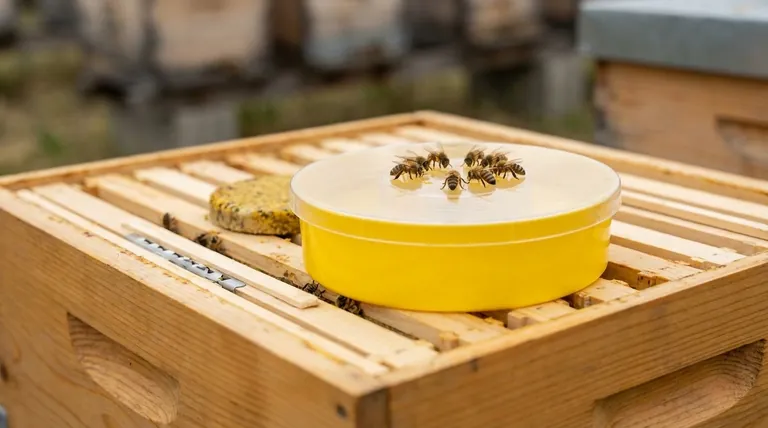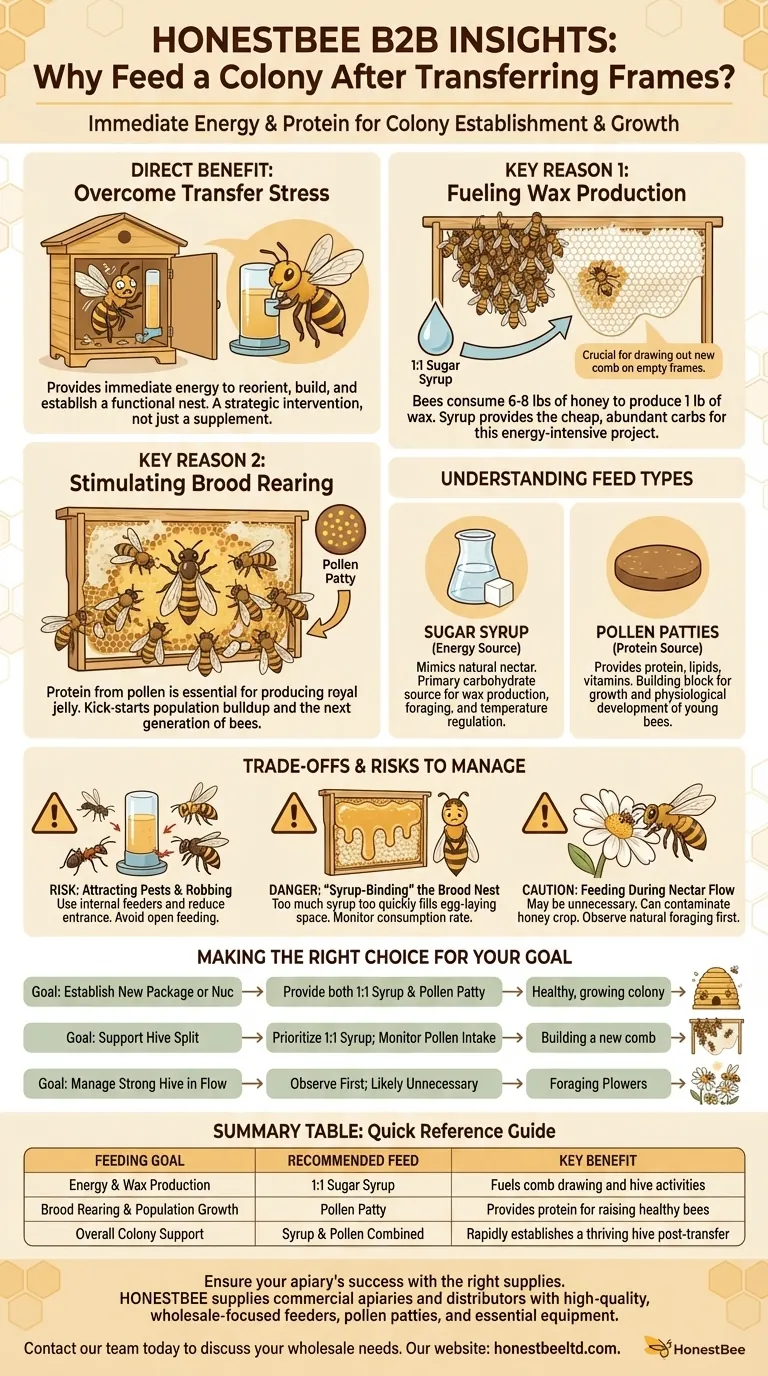Directly put, feeding a honeybee colony after transferring frames provides the immediate energy and protein needed to overcome the stress of the move. This support allows the bees to rapidly build new comb, establish a functional nest, and stimulate the queen to lay eggs, ensuring the colony thrives in its new environment.
A hive transfer is a moment of profound disruption for a colony. Feeding is not simply a supplement; it is a strategic intervention that provides the critical fuel for rebuilding and repopulating when the colony is at its most vulnerable.

Why Feeding is Critical After a Transfer
Transferring frames—whether from a nucleus box to a full hive, during a split, or after catching a swarm—resets the colony's immediate environment. This creates an urgent need for resources.
Overcoming Transfer Stress
A transfer disrupts the hive's delicate internal organization. Foraging patterns are interrupted, and the bees must reorient themselves, which consumes significant energy.
Providing an internal food source like sugar syrup allows the bees to focus their energy on immediate in-hive tasks rather than having to immediately mount a large-scale foraging effort.
Fueling Wax Production
When placed in a new hive with empty frames, the colony's primary job is to "draw out" comb. Bees produce wax flakes from glands on their abdomens, a process that is incredibly energy-intensive.
Studies show bees may consume 6-8 pounds of honey or syrup to produce just one pound of wax. Feeding 1:1 sugar syrup provides the cheap, abundant carbohydrates necessary to fuel this massive construction project.
Stimulating Brood Rearing
A colony's long-term survival depends on population growth. For the queen to lay eggs and for nurse bees to raise the larvae, they need protein, which comes from pollen.
A pollen patty or substitute provides a concentrated protein source. This ensures the nurse bees can produce the royal jelly needed to feed the queen and developing brood, kick-starting the next generation of bees without delay.
Understanding the Types of Feed
Different types of feed serve distinct biological purposes. Knowing which to use is key to effective management.
Sugar Syrup for Energy
Sugar syrup (typically a 1:1 ratio of sugar to water by weight) mimics natural nectar. It provides pure carbohydrates, which are the bees' primary source of energy.
This energy is used for all hive functions, but it is especially critical for wax production, foraging, and temperature regulation in the new hive.
Pollen Patties for Protein
Pollen patties are a mixture of pollen or pollen substitute, sugar, and fats. They are the colony's source of protein, lipids, vitamins, and minerals.
Protein is not used for energy but as a building block for growth. It is essential for raising brood and for the physiological development of young bees. This is why it's directly linked to population buildup.
Understanding the Trade-offs and Risks
While beneficial, feeding is not without risks and must be done thoughtfully. Improper feeding can create more problems than it solves.
Risk of Attracting Pests
Open or messy feeders can attract ants, wasps, and hornets. More significantly, a weak colony being fed can trigger "robbing" from stronger nearby hives, which can quickly decimate the new colony.
Internal feeders (like frame or top-hive feeders) are strongly recommended to minimize this risk. The hive entrance should also be reduced to a smaller opening that is easier for the colony to defend.
The Danger of "Syrup-Binding" the Brood Nest
If you provide too much syrup too quickly, the bees may store it in the cells of the brood nest where the queen should be laying eggs.
This condition, known as being "honey-bound" or "syrup-bound," can shut down brood production entirely. Feed should be given at a measured pace that matches the colony's consumption rate.
Feeding During a Nectar Flow
If you transfer frames during a strong natural nectar flow, supplemental feeding may be unnecessary. A strong colony will be able to gather all the resources it needs.
Feeding syrup when natural nectar is abundant can also lead to the bees storing sugar syrup in the honey supers, which contaminates the honey crop you intend to harvest.
Making the Right Choice for Your Goal
Your feeding strategy should align with your specific objective for the colony.
- If your primary focus is establishing a new package or nuc: Provide both 1:1 sugar syrup and a pollen patty to simultaneously fuel rapid comb construction and population growth.
- If your primary focus is supporting a hive split: Prioritize 1:1 sugar syrup to help the bees draw new comb for their established queen, but monitor their natural pollen intake before adding a patty.
- If your primary focus is managing a strong, established hive moved during a nectar flow: Observe first. Feeding is likely unnecessary and could interfere with natural foraging and honey production.
Ultimately, thoughtful feeding is a powerful tool that transforms a disruptive transfer into an opportunity for controlled, accelerated growth.
Summary Table:
| Feeding Goal | Recommended Feed | Key Benefit |
|---|---|---|
| Energy & Wax Production | 1:1 Sugar Syrup | Fuels comb drawing and hive activities |
| Brood Rearing & Population Growth | Pollen Patty | Provides protein for raising healthy bees |
| Overall Colony Support | Syrup & Pollen Combined | Rapidly establishes a thriving hive post-transfer |
Ensure your apiary's success with the right supplies.
At HONESTBEE, we understand that a smooth hive transfer is vital for the health of your colonies and the productivity of your operation. We supply commercial apiaries and beekeeping equipment distributors with the high-quality, wholesale-focused supplies needed to support critical beekeeping practices, like post-transfer feeding.
Let us be your reliable partner in beekeeping success. Contact our team today to discuss your wholesale needs for feeders, pollen patties, and other essential equipment.
Visual Guide

Related Products
- HONESTBEE Round Hive Top Bee Feeder for Syrup
- HONESTBEE Entrance Bee Feeder Professional Hive Nutrition Solution for Beekeeping
- Rapid Bee Feeder White Plastic 2L Round Top Feeder for 8 or 10-Frame Bee Hives
- HONESTBEE Entrance Bee Feeder Efficient Hive Front Liquid Feeding Solution for Beekeeping
- Classic Boardman Entrance Bee Feeder Hive Front Feeding Solution
People Also Ask
- What can the round hive top feeder be used for? A Guide to Efficient, Safe Bee Feeding
- Why is a top feeder essential for bees? Ensure Colony Health and Efficiency
- How do hive top feeders work? A Guide to Efficient, High-Capacity Bee Feeding
- How do you set up and use a top feeder for bees? A Step-by-Step Guide for Safe Feeding
- How should syrup for bees be prepared? Master the Ratio for a Thriving Hive



















